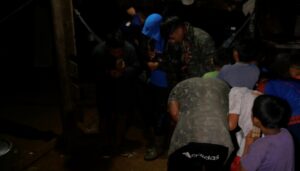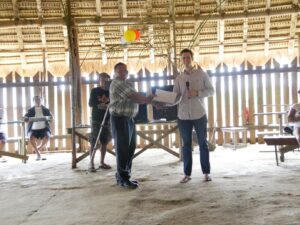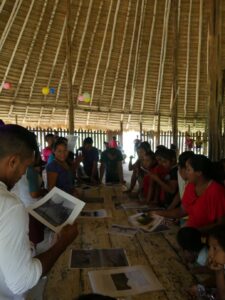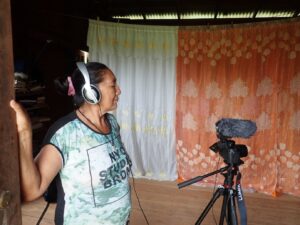Engaged Anthropology Grant: R. Elliott Oakley

While a doctoral student at the University of Edinburgh, Elliott Oakley received a Dissertation Fieldwork Grant in 2015 to aid research on “Counting Fingers, Quantifying Forests: Numbers, Translation and Guyanese Eco-Politics,” supervised by Dr. Casey High. Three years later Dr. Oakley received an Engaged Anthropology Grant to aid engaged activities on “Supporting Waiwai ‘Cultural Preservation’ in the Context of Conservation.”
The Waiwai Village Museum began as a community initiative to generate income for residents of Masakenyarï, an indigenous community in southern Guyana. Part of a protected area partnership, the Kanashen Community-Owned Conservation Area, the Museum was envisioned as a way to showcase Waiwai culture and sell handicrafts to visitors. My dissertation research (2015-2017) demonstrated how community ideas of the protected area frame conservation as a process of building connections, more to international NGOS, the Guyanese government, or other outsiders than to the plants and animals that make up a lived Amazonian environment. As tourists failed to arrive with any real consistency, over the course of my fieldwork many people in Masakenyarï began to doubt the Museum’s potential to provide greater access to money. But interest in a formal space for local histories, language resources, cultural materials, and Waiwai crafts endured.

While writing my doctoral thesis in Edinburgh, I was fortunate to visit collections in Glasgow and London containing materials from southern Guyana, most obtained in the mid twentieth century during colonial rule of British Guiana. I sent pictures of the exhibitions – ‘Life in the Rainforest’ in Glasgow’s Kelvingrove Museum and the ‘American encounters’ section of the London’s Horniman Museum – to Waiwai friends in Guyana over Facebook. During fieldwork I had promised to adapt my research materials into resources that could be part of the Village Museum in Masakenyarï. But, in part prompted by the images of these UK museums, I learned that the Village Museum stood empty. My discussions with community leaders and elders led to an Engaged Anthropology Grant with three aims: sharing doctoral research findings with participants in Masakenyarï; working with the community on alternative visions to re-establish the Waiwai Village Museum; and filming Waiwai Christmas celebrations, connected to traditional kesemanitopo or Shodewika festivals, to contribute to the establishment of a community-operated digital archive of cultural practices and related research outputs.
Before returning to Guyana, I visited Glasgow Museums to consult their Waiwai collections with curators Patricia Allan and Ed Johnson. The widow of the Scottish colonial official Gordon Lethem, Governor of British Guiana for part of the 1940s, donated assorted objects and photographs from southern Guyana to Glasgow Museums. Many of the objects – and most of the black-and-white images – have not been digitized, and I was lucky to view them and take reference photographs to share with people in Masakenyarï.

Arranging the two-month trip to Guyana to start in December 2018 allowed sharing research findings and discussing the Village Museum to coincide with Christmas celebrations, which people often referred to as the most significant cultural event to document to communicate their identity. Though people gather daily between Christmas and New Year’s to eat and dance, enacting this joyous sociality took clear precedence over my rather mundane suggestion to talk about my research. The main conclusion I sought to communicate was how building connections with outside peoples and places is fundamental to enacting the Waiwai ewto, the village or ‘place-where-people-live’. The December festivities were a firm reminder that these desires for exteriority are valuable insofar as they enable states of happiness and contentment, associated with village interiority and embodied most forcefully and deliberately at Christmas.
I felt the full weight of this insight when, while filming hunters returning to the village on December 23rd, the dugout canoe I was traveling in capsized. Gone, it seemed, was any chance of achieving the third project aim, with the camera equipment drying out in a bucket of rice. Immediately aware of my possible grief and frustration, several of the hunters passed arrows and portions of meat from their own hands to mine so I could walk with them into the village. Their generosity turned me from a position of observer to that of participant in a powerful way.

Upon checking four days later the camera worked as normal, much to our collective relief, and I was able to collaborate filming parts of the dancing and festivities. The focus shifted to ‘kwachi’, in which young men gather and walk from household to household waking up the women who will prepare food for the day’s communal meals.
Eventually, I was able to present my research at a village meeting on New Year’s Day. I said my formal thanks, discussed the research findings, presented village copies of the PhD and distributed printed summaries for each household. I donated an external hard drive, with photographs and videos from my doctoral research, Waiwai language materials, digital copies of anthropology publications focused on Waiwai people, and artefact images from museum collections in the UK, to start a ‘digital archive’ based in the village and operated by the community.
Then, the event shifted towards collaborative small-group discussions based around the assorted printed materials, which ranged from Lethem’s 1940s photographs to Guyanese newspaper archives from the 1970s to posters summarizing my doctoral research. It was a pleasure for me to move around the roundhouse listening as older generations recognized their kin or described the context of the images to their children and grandchildren.
After celebrations closed down after New Year’s Day, the village shifted from the continual daily gatherings to the much quieter rhythms of household life in an Amazonian community. With time to rest and to visit, I focused on discussing museum plans, translating a chapter summary of my PhD into the Waiwai language, and tying up filming by speaking with senior women about the significance of kwachi.
People in Masakenyarï discussed how museum artefacts and images collected decades before might offer a pathway forward for their heritage goals. Rather than rely on tourists arriving in person, their museum vision – like the conservation processes I documented during doctoral fieldwork – is to build connections through enduring outside interests in Amazonian objects, peoples, and places. We composed a letter to Glasgow Museums to take the next step in that effort.